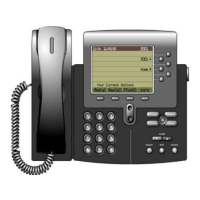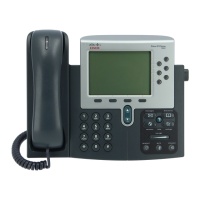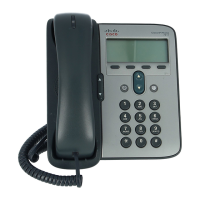2-17
Cisco SIP IP Phone Administrator Guide
Chapter 2 Getting Started with Your Cisco SIP IP Phone
Customizing the Cisco SIP IP Phone Ring Types
Customizing the Cisco SIP IP Phone Ring Types
The Cisco SIP IP phone ships with two ring types: Chirp1 and Chirp2. By default, your ring type options
will be those two choices. However, using the RINGLIST.DAT file, you can customize the ring types
that are available to the Cisco SIP IP phone users.
Step 1 Create a pulse code modulation (PCM) file of the desired ring types and store the PCM files in the root
directory of your TFTP server. PCM files must contain no header information and must comply with the
following format guidelines:
• 8000 Hz sampling rate
• 8 bits per sample
• u-law compression
Step 2 Using an ASCII editor, open the RINGLIST.DAT file and for each of the ring types you are adding,
specify the name as you want it to appear on the Ring Type menu, press Tab, and then specify the
filename of the ring type. For example, the format of a pointer in your RINGLIST.DAT file should appear
similar to the following:
Ring Type 1ringer1.pcm
Step 3 After defining pointers for each of the ring types you are adding, save your modifications and close the
RINGLIST.DAT file.
Creating Dial Plans
Dial plans enable the Cisco SIP IP phone to support automatic dialing and automatic generation of a
secondary dial tone. If a single dial plan is to be used for a system of phones, the dial plan is best
specified in the default configuration file. However, you can create multiple dial plans and specify which
phones are to use which dial plan by defining the dial_template parameter in the phone-specific
configuration file. If one phone in a system of phones needs to use a different dial plan than the rest, you
need to define the differing dial plan by specifying the dial_template parameter in that phone’s
phone-specific configuration file.
Note We recommend that you define the dial_template parameter in the default configuration file for
maintenance and control purposes. Specify the dial_template parameter in a phone-specific
configuration file only if that phone needs to use a different dial plan than is being used by the other
phones in the same system.
When creating a dial plan, remember the following:
• Dial plans must be in an .xml format and be stored on your TFTP server.
• You must specify which dial plan a phone is to use by specifying the path to the dial plan in the
dial_template parameter that you define in either the phone-specific configuration file or the default
configuration. We recommend that the dial_template parameter be defined in the default
configuration file unless a specific phone must use a dial plan that differs from the one being used
by other phones in the same system.

